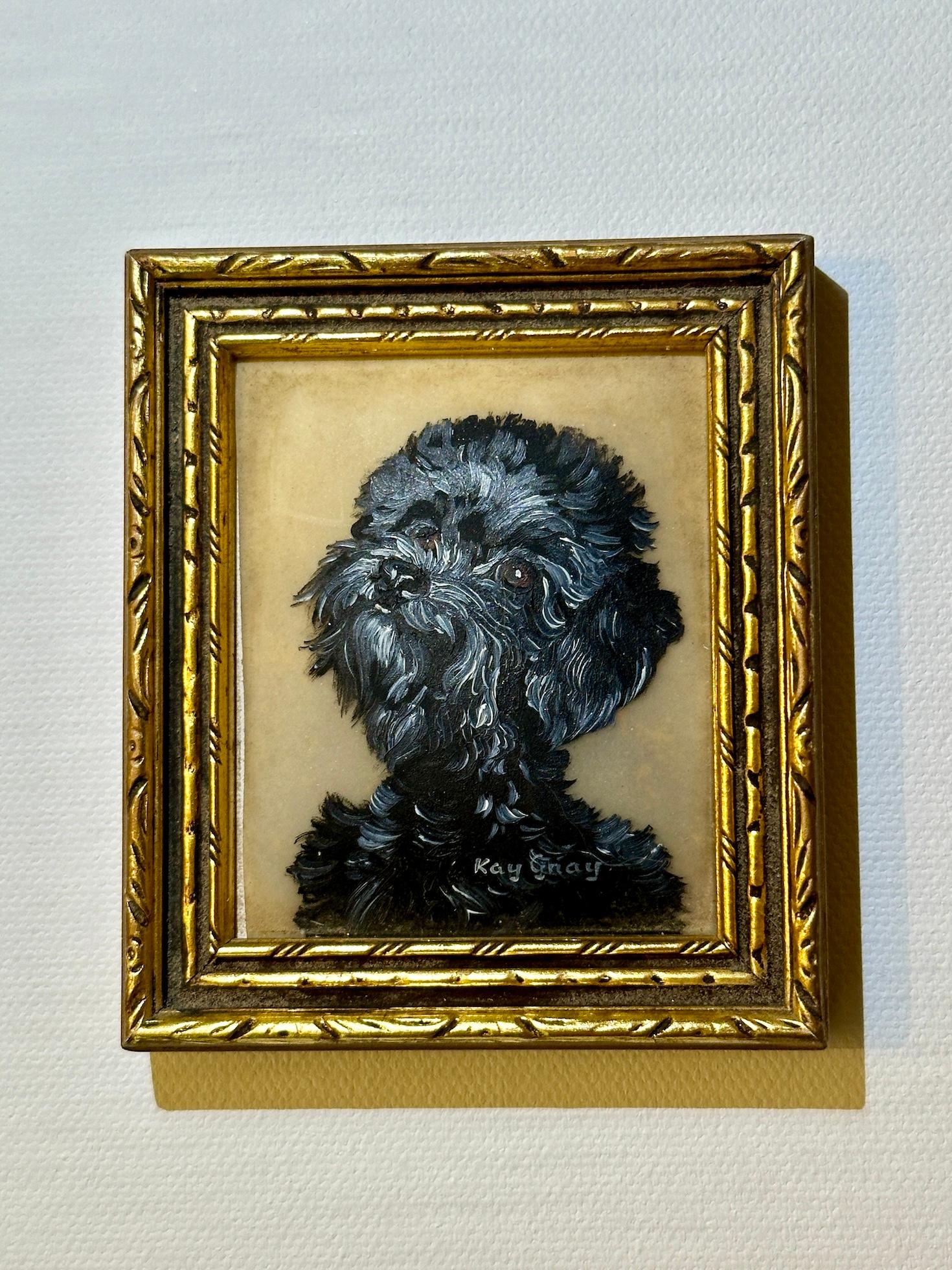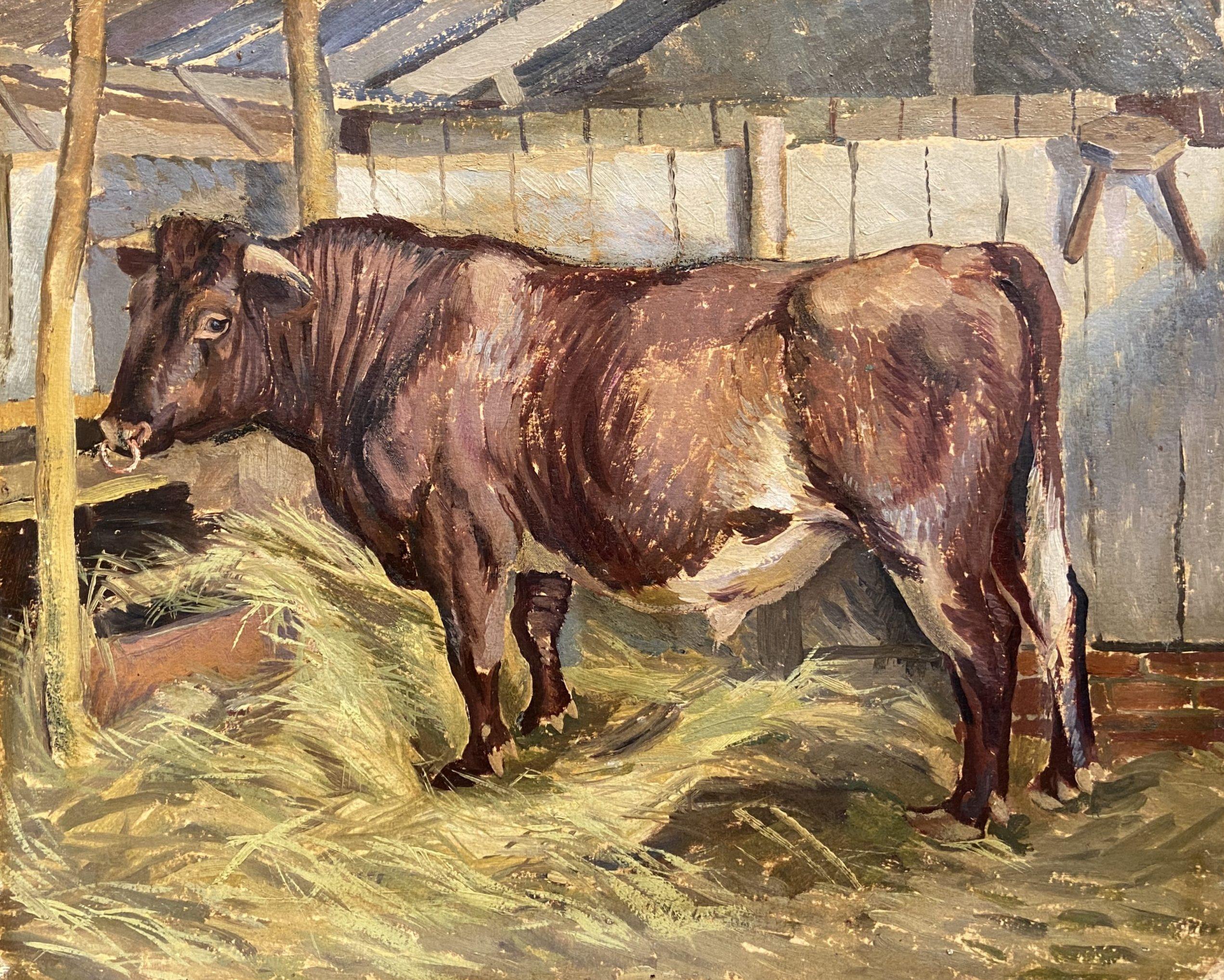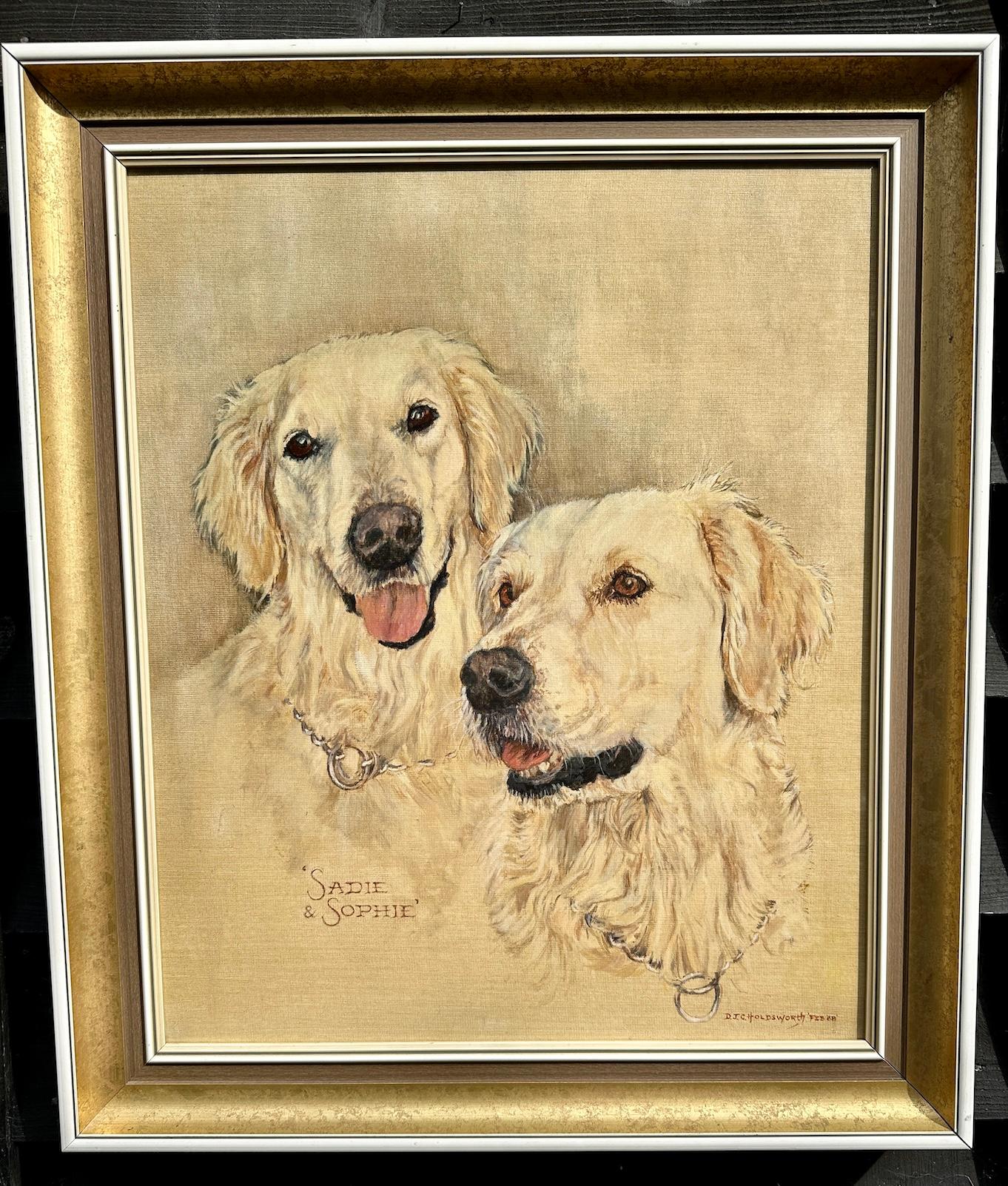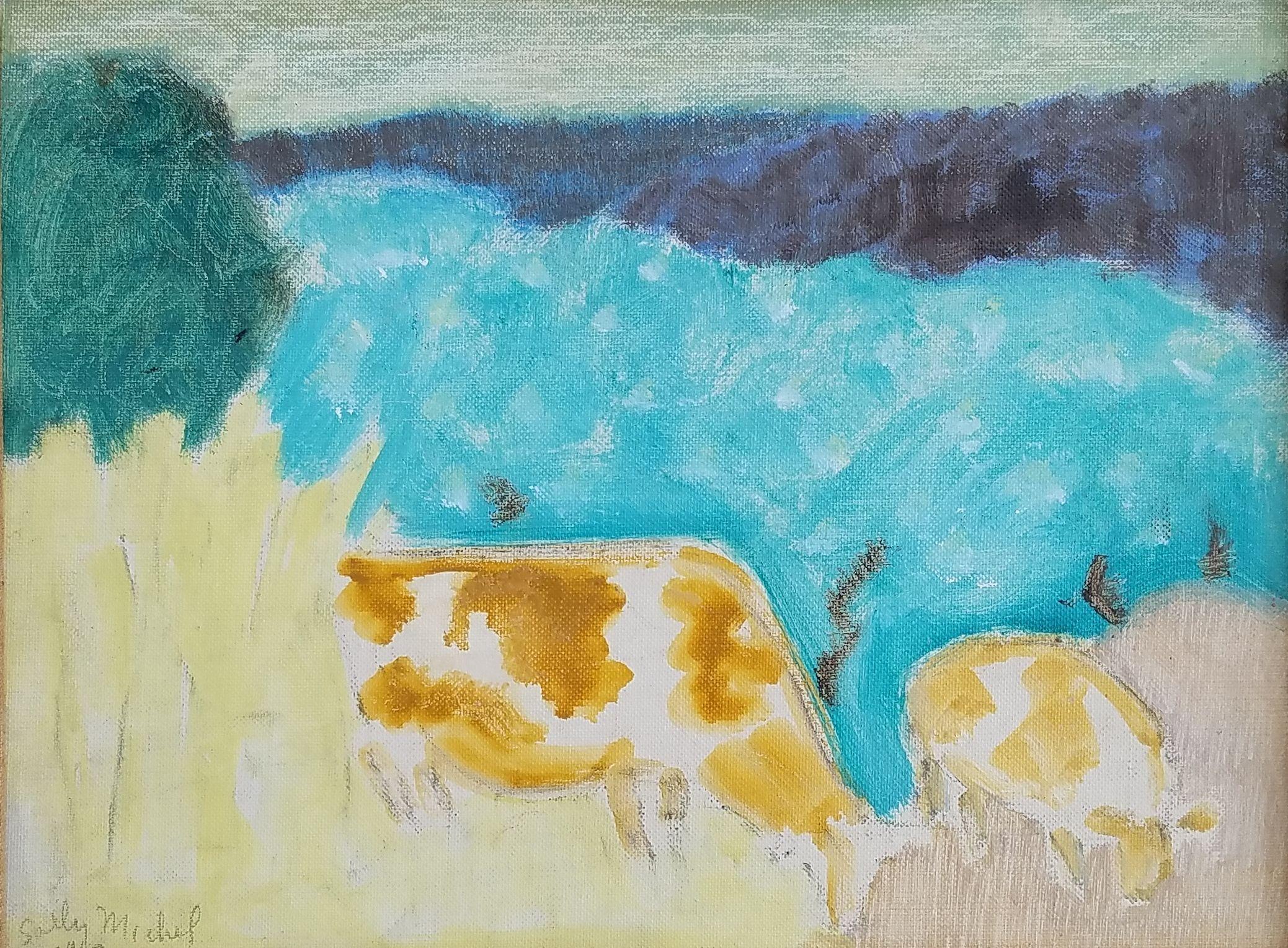Items Similar to Ponies at Penlan, 1967.Swansea.Wales.Welsh Pony.Valleys.Equestrian.Hot Sun.
Want more images or videos?
Request additional images or videos from the seller
1 of 24
Hazel M. BarnettPonies at Penlan, 1967.Swansea.Wales.Welsh Pony.Valleys.Equestrian.Hot Sun.1967
1967
About the Item
Hazel M. Barnett.
British.
Ponies at Penlan, Swansea, Wales.1967
Oil on Board. Signed.
Image size 17.9 inches x 35.6 inches ( 45.5cm x 90.5cm ).
Frame size 19.7 inches x 37.4 inches ( 50cm x 95cm ).
Available for sale from Big Sky Fine Art in the English county of Dorset, this original oil painting is by Hazel Barnett and dates from 1967.
The painting is presented and supplied in a sympathetic contemporary replacement frame (which is shown in these photographs).
This vintage painting is in very good condition, commensurate with its age. It wants for nothing and is supplied ready to hang and display.
The painting is signed with a monogram lower right.
This original oil on hardboard painting depicts half a dozen wild ponies grazing on the Penlan Slopes, an area of importance for nature conservation on the outskirts of Swansea, south Wales. The ponies form a familial group, with at least two foals, one of which is suckling from his mother. The ponies are calm and peaceful, and are painted in the hues of the natural environment around them. The evening sun is shown as a low orange ball of great intensity and its glow bathes the scene in a surreal light. This is a sympathetic and harmonious piece, appealing to nature lovers and horse lovers alike. The style is highly representative of Modern British mid-century homestyle of the 1960’s and 1970’s. Think Ercol, G-Plan, Heals, Conran, Gordon Russell, Robin Day …furniture and design.
- Creator:Hazel M. Barnett
- Creation Year:1967
- Dimensions:Height: 19.69 in (50 cm)Width: 37.41 in (95 cm)Depth: 1.78 in (4.5 cm)
- Medium:
- Movement & Style:
- Period:
- Condition:Very Good. Presented and supplied in a sympathetic contemporary frame (which is shown in these photographs). This vintage painting is in very good condition, commensurate with its age. It wants for nothing and is supplied ready to hang and display.
- Gallery Location:Sutton Poyntz, GB
- Reference Number:1stDibs: LU489314301012
About the Seller
5.0
Platinum Seller
These expertly vetted sellers are 1stDibs' most experienced sellers and are rated highest by our customers.
Established in 2010
1stDibs seller since 2016
110 sales on 1stDibs
Typical response time: 1 hour
- ShippingRetrieving quote...Ships From: Sutton Poyntz, United Kingdom
- Return PolicyA return for this item may be initiated within 14 days of delivery.
More From This SellerView All
- Zebra Mare and Foal. African Wildlife Scene.Safari.Animal. Original Oil PaintingBy Douglas Van HowdLocated in Sutton Poyntz, DorsetDouglas Van Howd. American ( b.1935 ). Zebra Mare and Foal. Oil on Board. Signed. Image size 10.6 inches x 13.6 inches ( 27cm x 34.5cm ). Frame size 19.3 inches x 22 inches ( 49cm x...Category
Late 20th Century Naturalistic Animal Paintings
MaterialsOil, Board
- Black Labrador. Original Dog Oil Painting Portrait . John Trickett. Framed.By John TrickettLocated in Sutton Poyntz, DorsetJohn Trickett. English ( b.1952 ). Black Labrador. Oil on Board. Signed. Image size 13.2 inches x 9.3 inches ( 33.5cm x 23.5cm ). Frame size 18.3 inches x 14.6 inches ( 46.5cm x 37c...Category
Late 20th Century Naturalistic Animal Paintings
MaterialsOil, Board
- Dame Elisabeth Frink. Hawk, 1969. Watercolor. A Representation of Destruction.By Elisabeth FrinkLocated in Sutton Poyntz, DorsetDame Elisabeth Frink. English ( b.1930 - d.1993 ). Hawk, 1969. Watercolor. Image size 25.4 inches x 19.5 inches ( 64.5cm x 49.5cm ). Frame size 34.4 inches x 28.1 inches ( 87.5cm x 71.5cm ). Available for sale; this original painting is by Dame Elisabeth Frink and is dated 1969. The painting is presented and supplied in a glazed frame and mount dating from June 1997. This vintage watercolor is in very good condition, commensurate with its age. The watercolor is signed and dated lower right. Previously with Beaux Arts, London and Bath in 1999. Dame Elisabeth Frink was one of Britain’s most important post-war sculptors, an accomplished draughtsman, illustrator and teacher. She was part of the post-war school of expressionist British sculptors dubbed the Geometry of Fear, and enjoyed a highly acclaimed career that was commercially successful, broke boundaries and contributed greatly to bringing wonderful sculpture to public places. She was born on 14 November 1930 in Thurlow, the daughter of a cavalry officer, and brought up in rural Suffolk near to an active airbase. She was brought up a Catholic and educated at the Convent of the Holy Family, Exmouth. She then studied at the Guildford School of Art from 1947-1949 under Willi Soukop and Henry Moore’s assistant, Bernard Meadows, and then at the Chelsea School in London 1949-1953. She taught at Chelsea School of Art 1951-61, St. Martin’s School of Art 1954-62 and was a visiting instructor at the Royal College of Art 1965-1967, after which she lived in France until 1973. Frink first came to the attention of the public in 1951 at an exhibition at the Beaux Arts Gallery, London. In 1952 she represented Britain at the Venice Biennale, being described by Herbert Read as “the most vital, the most brilliant and the most promising of the whole Biennale”. The same year the Tate bought its first work by her, and she began to enjoy commercial success. Thereafter she exhibited regularly and was for 27 years associated with Waddington’s, London. The subjects which Frink was most concerned with were man, dog and horses, with and without riders. Interestingly she seldom sculpted the female form, drawing on archetypes of masculine strength, struggle and aggression. Her work has the recurring themes of the vulnerable and the predatory, in the spirit of an authentic post-war artist. It has been said that she was more concerned with representing mankind that portraits of individuals. The appeal of her work lies in its directness, provoking a frank statement of feeling. The anatomy is often exaggerated or incorrect; the impact growing more out of her interest in the spirit of the subject. Her animals and birds may be drawn from nature but verge on the abstract, conveying raw emotion and character rather than a realistic depiction. Her unique style is characterised by a rough treatment of the surface which embeds each piece with vitality and her personal impression. In her later work even the distinction between human and bird figures becomes blurred. Commentators have noted that the often rugged, brutal and contorted surfaces of her work reflect the destruction and terror of the six-year world-wide conflict that she witnessed as a child. Frink was an active supporter of Amnesty International. In the 1960s and early 1970s Frink produced a notable series of falling figures and winged men. Later, living in France during the Algerian war, she began making heads, blinded by goggles which had a threatening facelessness. Frink produced many notable public commissions, including Wild Boar for Harlow New Town, Blind Beggar and Dog for Bethnal Green, Noble Horse and Rider for Piccadilly, London, a lectern for Coventry Cathedral, Shepherd for Paternoster Square beside St. Paul’s Cathedral and a Walking Madonna for Salisbury Cathedral. In the early 1980s she produced a set of three larger than life figures The Dorset Martyrs which stand on the edge of the old walled town of Dorchester on the site of the old gallows, as a memorial to those who had been executed there ‘for conscience sake’. Frink’s Canterbury Tales was a collection of 19 etchings drawn directly on to copper plates and etched by her. The ‘book’ was issued in three limited editions. Her illustrations have been praised as “amongst the most successful illustrations of the century, encompassing the mood of the text in concise delineations and disarmingly ribald humour”. She illustrated other books with colored lithographs or drawings. Frink was on the Board of Trustees, British Museum from 1976, and was a member of the Royal Fine Art Commission 1976-81. CBR (1969), DBE ((1982), Associate of the Royal Academy (1971), Royal Academy (1977). She was made a Companion of Honour in 1992. She died on 18 April 1993, but not before completing her last commission, a monumental but unusual figure of Christ for the front of the Anglican Cathedral in Liverpool, unveiled a week before her death. For several decades Frink exhibited widely in the UK and abroad. In her later years she lived and worked in Dorset where her home and garden became an arena for her work. In 1985 she had a retrospective at the Royal Academy. She died on 18 April 1993, but not before completing her last commission, a monumental but unusual figure of Christ for the front of the Anglican Cathedral in Liverpool, unveiled a week before her death. There was a memorial show at Yorkshire Sculpture Park, Bretton Hall in 1994. Today Frink is venerated as one of the great twentieth century British sculptors. Her unique work is represented in the Tate Gallery and major public and private collections world-wide. © Big Sky Fine Art This original watercolor on paper painting of a hawk by Dame Elizabeth Frink...Category
Mid-20th Century Modern Animal Paintings
MaterialsPaper, Watercolor
- Dartmoor Ponies. Early Morning Mist and Haze. Devon Moor Pony.1930s.Wild HorsesBy Charles Walter SimpsonLocated in Sutton Poyntz, DorsetCharles Walter Simpson. English ( b.1885 - d.1971 ). Dartmoor Ponies, Devon. Oil on Board. Signed lower right. Image size 20.7 inches x 28.2 inches ( 52.5cm x 71.5cm ). Frame size 29...Category
1930s Impressionist Animal Paintings
MaterialsOil
- Highland Cattle in the Margins of a Loch. Scottish Cows. Scotland. Victorian.Located in Sutton Poyntz, DorsetHenry Robinson Hall. English ( b.1857 - d.1927 ). Highland Cattle in the Margins of a Scottish Loch Oil on Canvas. Signed lower left. Image size 23.4 inches x 15.4 inches ( 59.5cm x ...Category
Late 19th Century Victorian Animal Paintings
MaterialsCanvas, Oil
- Highland Cattle in Scottish Upland Pasture, 1891. Scottish Cows. Scotland.Located in Sutton Poyntz, DorsetHenry Robinson Hall. English ( b.1857 - d.1927 ). Highland Cattle in Scottish Upland Pasture, 1891 Oil on canvas. Signed lower and dated lower left. Image size 23.4 inches x 15.4 inc...Category
Late 19th Century Victorian Animal Paintings
MaterialsCanvas, Oil
You May Also Like
- Musicians and dog oil on board paintingLocated in Barcelona, BarcelonaAlbert Roca (1945) - Musicians - Oil on panel Oil measures 50x70 cm. Frame measures 53x73 cm. Painter of landscapes and figures, in whose characterization...Category
1990s Modern Animal Paintings
MaterialsOil, Board
- English mid century oil painting Portrait of Miniature Black PoodleLocated in Woodbury, CTEnglish mid century oil painting Portrait of a Miniature Poodle Kate Gray was a British animal portrait painter during the last half of the 20th century. She also painted flower subj...Category
1960s Modern Animal Paintings
MaterialsOil, Board
- Little Bull, 20th Century Farmyard Oil Painting, Signed and InscribedBy Gerald CooperLocated in London, GBOil on board, signed and inscribed on reverse Image size: 16 x 19 1/2 inches (40.5 x 49.5 cm) A charming painting of a Bull in a farmyard. The intense realism of the work elevates t...Category
Mid-20th Century Modern Animal Paintings
MaterialsOil, Board
- 20th century English portrait of two Labrador Retriever dogs Sadie & SophieLocated in Woodbury, CT20th-century English portrait of two Labrador Retriever dogs Sadie & Sophie Owning a painting of two English Labrador Retriever dogs by D.J. Holdswor...Category
1980s Modern Animal Paintings
MaterialsCanvas, Board, Oil
- "Woman with Bird, " Nahum Tschacbasov, figurative, modern, 1956By Nahum TschacbasovLocated in Wiscasset, MEBorn in Baku, Russia in 1899, prolific avant-garde artist and painter Nahum Tschacbasov studied in Paris with Leopold Gottlieb, Marcel Gromaire and Fe...Category
1950s Modern Figurative Paintings
MaterialsOil, Board
- "Bucolic Landscape, " Sally Michel Avery, Female American Modernist Bright PastelBy Sally Michel-AveryLocated in New York, NYSally Michel Avery (1902 - 2003) Bucolic Landscape with Cows, 1963 Oil on canvasboard 9 x 12 inches Signed and dated lower left Provenance: The art...Category
1980s American Modern Landscape Paintings
MaterialsBoard, Oil, Canvas




